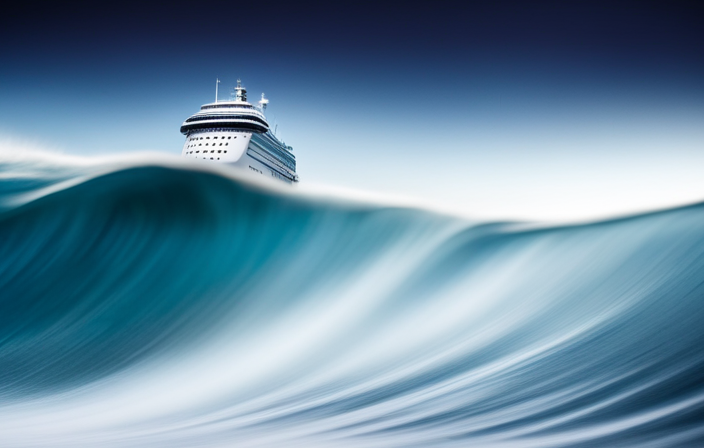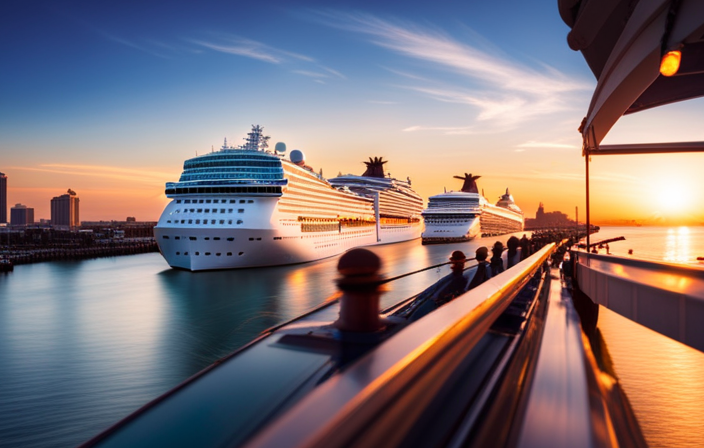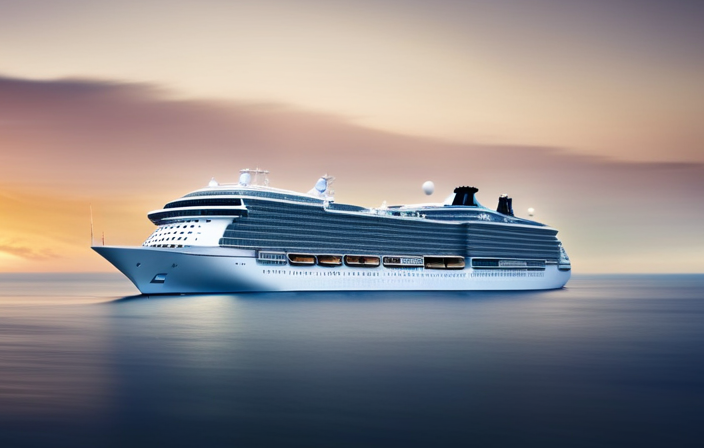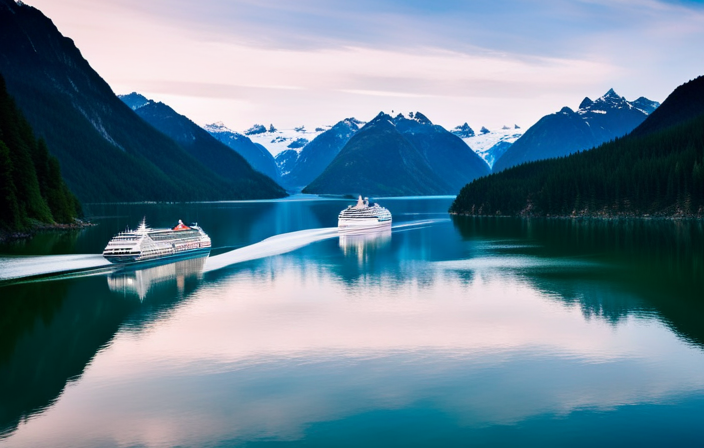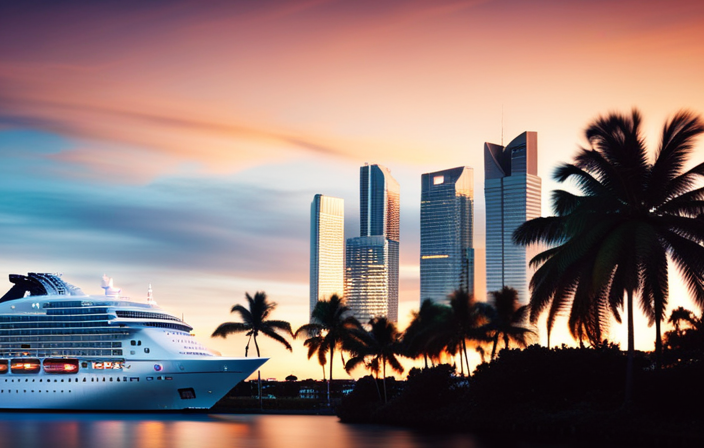As I stand on the expansive deck of an enormous cruise ship, surrounded by the endless expanse of the open sea, I am completely amazed by the amazing speed at which this large ship travels. Wondering how fast a cruise ship can go? It’s worth mentioning, it’s far from a leisurely stroll.
These magnificent vessels are designed to glide through the water with impressive velocity, whisking passengers away to exotic destinations in record time. The speed at which a cruise ship can travel is influenced by various factors, including engine power, propulsion systems, and even the shape of the hull. But it doesn’t stop there. Weather conditions and sea state also play a significant role in determining the ship’s speed.
In this article, we will delve into the intricate details of cruise ship speeds, exploring the technology and engineering behind their impressive velocity. We will also discuss safety measures, environmental considerations, and the future of cruise ship speeds. So, fasten your seatbelts, because we’re about to embark on a journey into the world of high-speed cruising.
Key Takeaways
- Weather conditions and ocean currents are factors that can affect the speed of a cruise ship.
- The engine and propulsion systems, including diesel engines and advanced fuel injection systems, play a crucial role in achieving high power output and fuel efficiency.
- The design and hull shape of a cruise ship are important in minimizing drag and resistance, as well as ensuring stability and maneuverability.
- The balance between speed and fuel efficiency is a key consideration, and innovations in propulsion and hull design are continuously being developed to improve both aspects.
The Basics of Cruise Ship Speeds
If you’re curious about cruise ship speeds, you’ll be amazed at how fast they can go! Cruise ship acceleration is an impressive feat of engineering. These colossal vessels can reach speeds of up to 24-30 knots, which is equivalent to 27-34 miles per hour.
The impact of speed on the passenger experience is multifaceted. As the ship moves faster, the sensation of movement becomes more pronounced, and passengers may feel a slight sway. However, modern stabilizers and advanced design techniques minimize this effect, ensuring a comfortable voyage for most travelers. Additionally, higher speeds can reduce travel time, allowing passengers to visit more destinations within a limited timeframe.
Factors affecting cruise ship velocity include weather conditions, ocean currents, and the ship’s size and weight. These elements will be explored in more detail in the subsequent section about factors affecting cruise ship velocity.
Factors Affecting Cruise Ship Velocity
To increase the velocity of a cruise ship, you should consider factors such as wind speed, water current, and the ship’s weight distribution. These factors can affect the ship’s ability to reach its top speed. Cruise ship fuel efficiency is a key factor in determining the ship’s speed. The ship’s propulsion systems and engine power play a crucial role in achieving higher velocities.
The impact of water currents cannot be underestimated, as they can either aid or hinder the ship’s progress. Strong currents can slow down the ship, while favorable currents can help increase its speed. Additionally, the ship’s weight distribution affects its maneuverability and stability, which in turn affects its velocity.
Taking these factors into account is essential for optimizing the cruise ship’s speed and fuel efficiency. Moving on to the next section, engine power and propulsion systems are vital components in determining a cruise ship’s speed and performance.
Engine Power and Propulsion Systems
Boost your cruise ship’s speed and performance by maximizing engine power and utilizing efficient propulsion systems.
When it comes to engine efficiency, there are several factors to consider. First, choosing the right type and size of engine is crucial. Diesel engines are commonly used due to their high power output and fuel efficiency.
Second, optimizing fuel consumption plays a vital role in increasing speed. This can be achieved through advanced fuel injection systems and improved combustion efficiency.
Third, selecting the right propulsion system is essential. Options include fixed-pitch propellers, controllable-pitch propellers, and podded propulsion systems.
Finally, implementing advanced technologies such as turbocharging and waste heat recovery systems can further enhance engine performance. By focusing on engine power and propulsion systems, cruise ship operators can maximize speed, efficiency, and overall performance.
This leads us to the next section about design and hull shape, where vessel characteristics play a significant role in determining speed and fuel consumption.
Design and Hull Shape
Maximizing the design and hull shape of your cruise ship is essential for achieving optimal speed and fuel efficiency. The aerodynamics and hydrodynamics of the ship play a crucial role in determining its performance.
The design of the ship’s hull is carefully engineered to minimize drag and resistance, allowing it to cut through the water with ease. This is achieved by shaping the hull in a way that reduces turbulence and promotes smooth flow. The streamlined design reduces the ship’s overall resistance, enabling it to achieve higher speeds while consuming less fuel.
Additionally, the hull shape helps to improve stability and maneuverability in various weather conditions and sea states. By considering the principles of aerodynamics and hydrodynamics in the design and hull shape, cruise ships can achieve optimal performance and provide a smoother sailing experience for passengers.
Weather Conditions and Sea State
Imagine yourself aboard a majestic cruise ship, gliding effortlessly through the treacherous seas, gracefully navigating the unpredictable weather conditions and sea states, providing you with a serene and enchanting journey. When it comes to the speed of a cruise ship, it is influenced by various factors, such as sea currents and wind speed. Sea currents can either assist or hinder the ship’s progress, affecting its overall speed. Additionally, the impact of wind speed must be taken into consideration. Headwinds can slow down a cruise ship, while tailwinds can help it gain speed. To better understand the relationship between these factors and a cruise ship’s speed, refer to the table below.
| Weather Condition | Impact on Ship’s Speed |
|---|---|
| Strong headwinds | Decreases speed |
| Strong tailwinds | Increases speed |
| Calm conditions | Maintains speed |
| Favorable currents | Increases speed |
Now, let’s delve into the discussion about the maximum speed vs. cruising speed of a cruise ship.
Maximum Speed vs. Cruising Speed
In my previous discussion on weather conditions and sea state, I highlighted the importance of these factors in determining the speed of a cruise ship.
Now, let’s delve into the concept of maximum speed versus cruising speed. A cruise ship’s maximum speed refers to the highest attainable speed it can reach, while cruising speed refers to the speed at which it typically operates during a voyage.
The cruising speed is often slower than the maximum speed as it ensures fuel efficiency and minimizes environmental impact on marine life. By operating at a slower speed, cruise ships can optimize their fuel consumption and reduce emissions, thus promoting sustainability and protecting the delicate ecosystems they traverse.
Understanding the balance between maximum speed and fuel efficiency is crucial for cruise ship operators to strike a harmonious relationship with the environment.
Moving forward, let’s explore the fascinating world of record-breaking cruise ships.
Record-Breaking Cruise Ships
To fully appreciate the extraordinary achievements of record-breaking cruise ships, you must consider the remarkable feats they accomplish. These ships have pushed the boundaries of maritime engineering, introducing record-breaking cruise ship innovations and advancements in cruise ship propulsion.
One such innovation is the introduction of Azipod propulsion systems, which provide enhanced maneuverability and increased fuel efficiency. These systems utilize electric motors mounted on pods that can rotate 360 degrees, allowing for precise control and improved performance.
Additionally, record-breaking cruise ships have incorporated advanced hull designs that reduce drag and increase speed. These innovations have resulted in cruise ships reaching unprecedented speeds, with some exceeding 30 knots.
As we delve into the next section about safety measures and restrictions, it’s important to recognize the ingenuity and technical prowess that have propelled the cruise ship industry forward.
Safety Measures and Restrictions
After discussing the impressive speed capabilities of record-breaking cruise ships, it’s crucial to shift our attention to the safety measures and restrictions that govern these vessels.
Cruise ships are bound by a set of stringent safety regulations to ensure the well-being of passengers and crew. These regulations encompass various aspects, including the construction and maintenance of the ship, as well as the implementation of emergency procedures.
Cruise ships are equipped with state-of-the-art safety systems, such as lifeboats, life rafts, and life jackets, to address potential emergencies. Crew members undergo rigorous training to handle various scenarios and are well-versed in executing evacuation plans. Additionally, regular safety drills are conducted to familiarize passengers with emergency procedures.
Adhering to these safety measures ensures that passengers can enjoy their cruise experience with peace of mind.
Transitioning to our next section, let’s now delve into the environmental considerations associated with cruise ship operations.
Environmental Considerations
Take a moment to consider the impact that cruise ship operations can have on the environment, such as the potential for water pollution caused by improper waste disposal.
For instance, imagine if a cruise ship accidentally discharged untreated wastewater into a sensitive marine ecosystem, resulting in harm to marine life and the surrounding habitat.
Another important environmental consideration is the carbon footprint of cruise ships. These massive vessels consume a significant amount of fuel, which releases greenhouse gases into the atmosphere.
To address this issue, cruise ship companies are continuously working on improving fuel efficiency by adopting advanced technologies and implementing energy-saving measures. By reducing fuel consumption, cruise ships can minimize their carbon emissions and decrease their impact on climate change.
Looking ahead, the future of cruise ship speeds will undoubtedly focus on finding a balance between maintaining high travel velocities and reducing environmental impacts.
The Future of Cruise Ship Speeds
Imagine cruising through the open seas on a majestic vessel, effortlessly gliding through the water, as the future of cruise ship speeds unveils a new era of exhilarating travel experiences.
The cruise industry is constantly seeking ways to enhance the speed and efficiency of their ships, and future advancements and technological innovations are set to revolutionize the way we travel on the high seas.
Engineers and designers are exploring the use of advanced propulsion systems, such as electric and hybrid engines, to improve fuel efficiency and reduce emissions.
Additionally, the development of new hull designs and materials, such as lightweight composites, will help to reduce drag and increase speed.
The future of cruise ship speeds promises faster, more environmentally friendly voyages, allowing passengers to reach their destinations quicker while enjoying a smoother and more sustainable journey.
Frequently Asked Questions
What are the top cruise ship destinations that require high cruising speeds?
When considering top cruise ship destinations that require high cruising speeds, it is important to analyze the cruise ship speed in the Arctic and compare it to the cruising speed versus maximum speed for cruise ships.
How do cruise ship speeds compare to other modes of transportation?
When comparing cruise ship speeds to other modes of transportation, it is important to note that the fastest cruise ships can reach speeds of up to 30 knots, which is equivalent to approximately 34.5 miles per hour.
Can cruise ships go faster during emergencies or urgent situations?
During emergency situations, cruise ships can achieve faster speeds than their normal cruising speed. This allows them to respond quickly to urgent situations and ensure the safety and well-being of passengers and crew on board.
How does the speed of a cruise ship affect fuel consumption and carbon emissions?
The speed of a cruise ship directly affects fuel efficiency and environmental impact. Higher speeds result in increased fuel consumption and carbon emissions, while slower speeds can improve fuel efficiency and reduce environmental harm.
Are there any regulations or guidelines in place to ensure the safety of cruise ship passengers in terms of speed?
Regulations and safety guidelines are strictly enforced to ensure the safety of cruise ship passengers. These measures cover various aspects such as speed limits, emergency procedures, and navigational protocols, prioritizing the well-being of passengers at all times.
How Fast Can I Expect a Cruise Ship Leaving from Baltimore to Go?
When it comes to cruise ships departing from Baltimore, the speed at which they initially travel can vary. Typically, cruise ships leaving from Baltimore will slowly navigate out of the inner harbor before picking up speed once they reach open waters. So, you can expect a gradual increase in speed after departure.
Conclusion
In conclusion, the speed of cruise ships is a fascinating and complex topic. Numerous factors come into play to determine how fast these floating giants can go, from engine power to hull design. While safety measures and environmental considerations are important, there is always a desire to push the boundaries and break records. But let’s not forget that the true purpose of a cruise ship is to provide a leisurely and relaxing experience for passengers. So perhaps we should focus less on speed and more on enjoying the journey.

